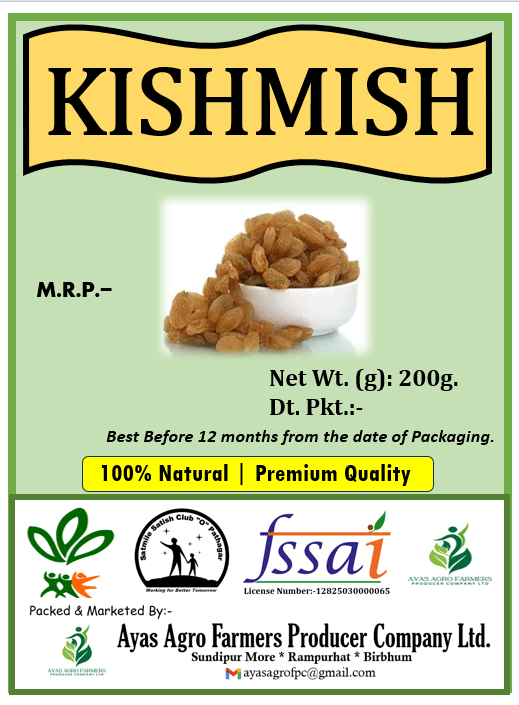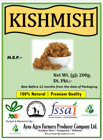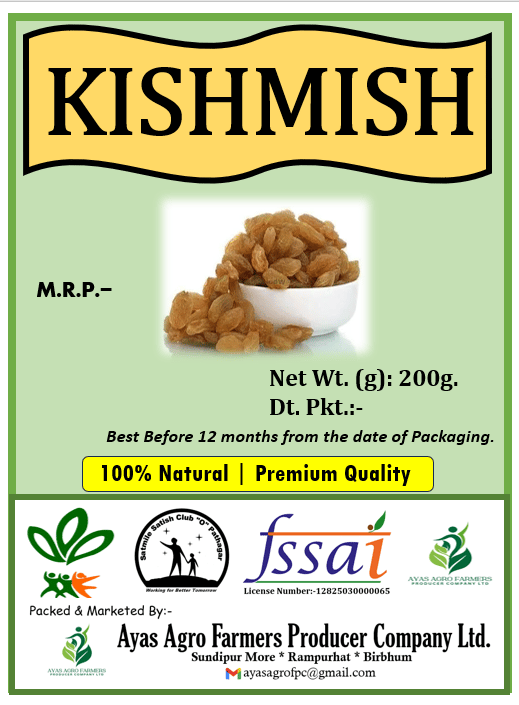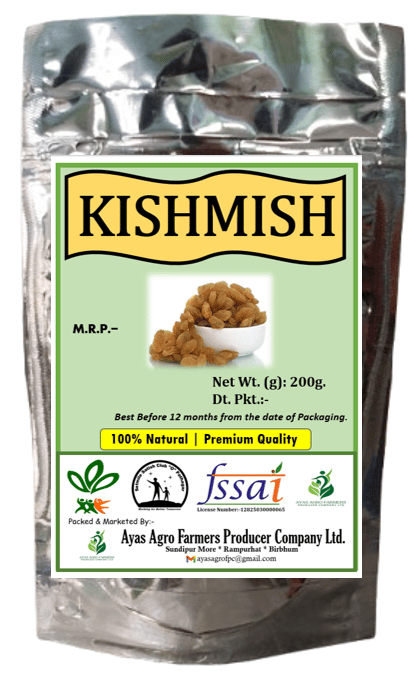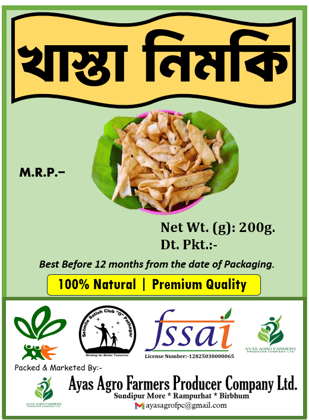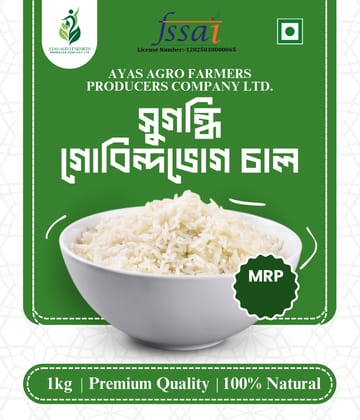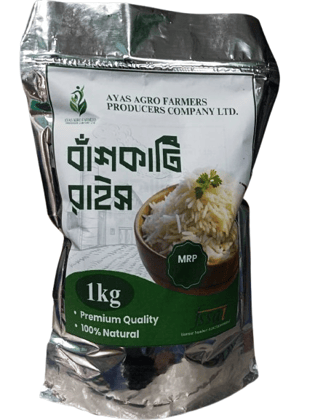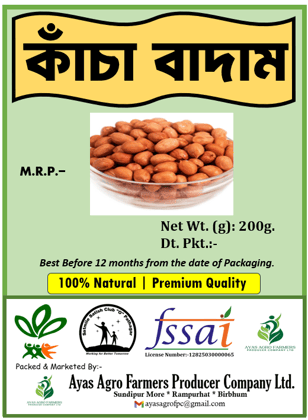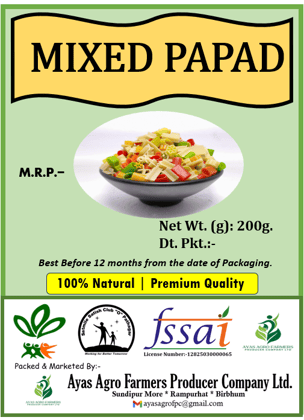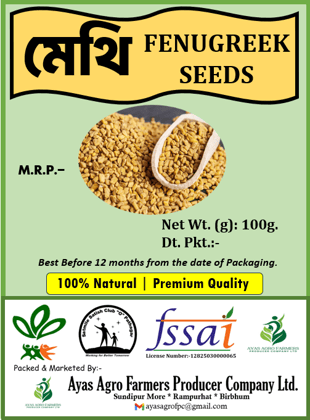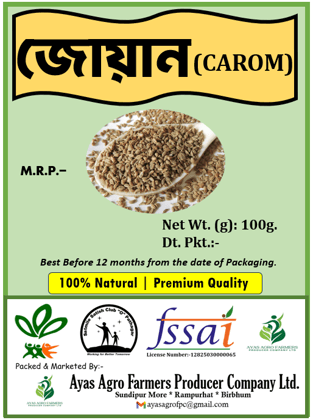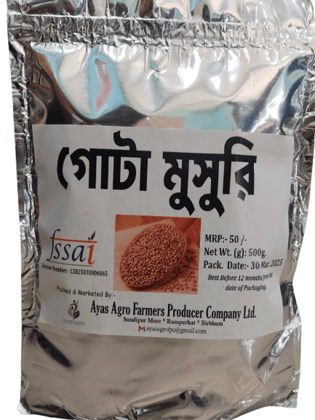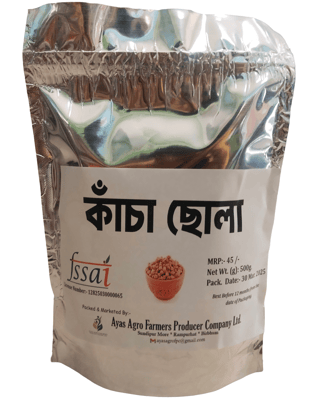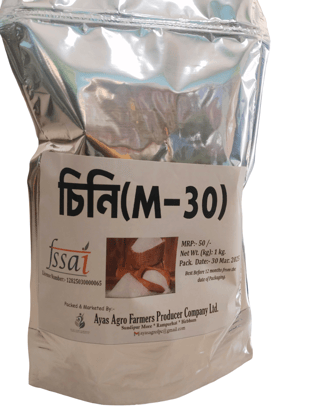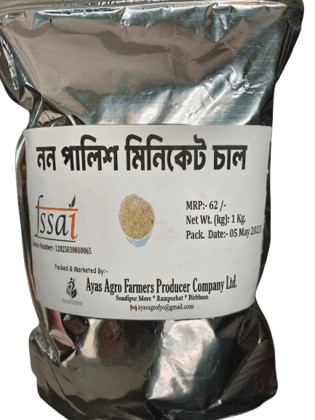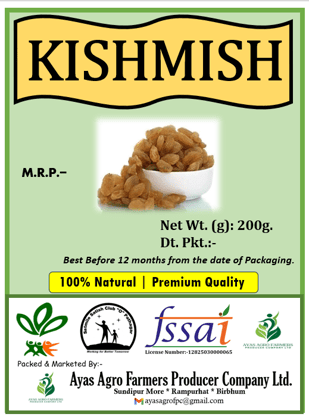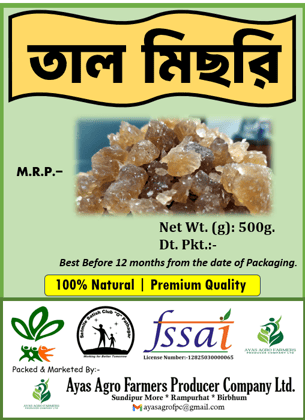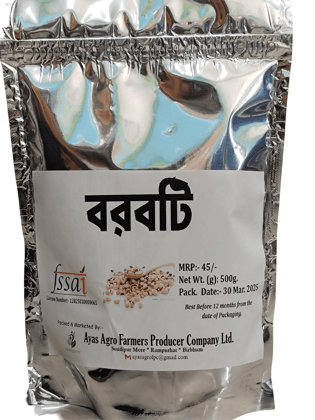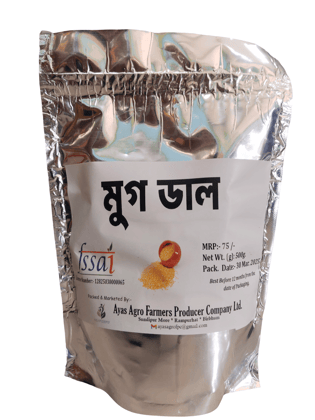- Kishmish are made by drying various types of grapes, either naturally under the sun or using mechanical dehydrators.
- The drying process concentrates the...
KISHMIS 200 Gm
Veg
Key Attributes
| Country of origin | India |
|---|---|
| Net Quantity | 200 gram |
| Product Dimensions | 18L x 11W x 18H cm |
| Manufacturer or packer name | Ayas Agro Farmers Producer Company Limited |
- Kishmish are made by drying various types of grapes, either naturally under the sun or using mechanical dehydrators.
- The drying process concentrates the sugars and nutrients present in the grapes, making kishmish a sweet and energy-dense food.
2. Characteristics:
- Appearance: Kishmish can vary in color from golden yellow (often called "golden raisins" or "yellow raisins") to dark brown, reddish, or even green, depending on the grape variety and drying method. They typically have a wrinkled appearance.
- Size & Shape: They are generally small to medium-sized, ranging from round to oval.
- Flavor: Intensely sweet, often with caramel-like undertones and a natural fruitiness. Some varieties might have a slightly tart note.
- Texture: Chewy and plump, with a slight stickiness due to their natural sugars.
3. Types of Kishmish/Raisins: While "kishmish" is a general term, different types exist based on the grape variety and processing:
- Golden Raisins (Sultanas): Often made from Thompson Seedless grapes, they are lighter in color and typically smaller. They are often treated with sulfur dioxide to retain their golden hue.
- Black Raisins: The most common variety, these are dark brown to black and often made from darker grape varieties.
- Red Raisins: Derived from red grape varieties like Flame Seedless, they are known for their vibrant color and rich flavor.
- Green Raisins: These are generally long, thin, and dark green, known for their juicy and soft texture.
- Munakka: While often confused with kishmish, munakka are larger, often dark brown, and typically contain seeds. They are known for a chewier texture and a richer taste.
4. Nutritional Value: Kishmish are a concentrated source of nutrients:
- Natural Sugars: Rich in glucose and fructose, providing a quick energy boost.
- Dietary Fiber: High in fiber, which aids digestion and helps prevent constipation.
- Vitamins: Contain various B vitamins, Vitamin C, Vitamin A, Vitamin K, and some folate.
- Minerals: Good source of potassium, iron, calcium, magnesium, copper, zinc, and phosphorus.
- Antioxidants: Packed with antioxidants like polyphenols, anthocyanins, and flavonols, which help fight oxidative stress and inflammation in the body.
5. Uses: Kishmish are incredibly versatile in culinary applications:
- Snacking: Popular as a healthy, convenient snack on their own or mixed in trail mixes with nuts and other dried fruits.
- Baking: Widely used in cakes, cookies, breads, muffins, and other desserts.
- Cooking: Added to savory dishes like pilafs, rice dishes, tagines, and curries to provide sweetness and texture.
- Breakfast Foods: Commonly sprinkled over oatmeal, yogurt, cereals, or granola.
- Beverages: Can be soaked in water (often overnight) for consumption, or even used in traditional beverages.
6. Health Benefits: Regular and moderate consumption of kishmish offers several health benefits:
- Aids Digestion: High fiber content promotes regular bowel movements and prevents constipation.
- Boosts Energy: Natural sugars provide an instant and sustained energy release.
- Supports Heart Health: Potassium helps regulate blood pressure, while antioxidants and fiber contribute to healthy cholesterol levels and reduce inflammation.
- Strengthens Bones: Contains calcium and boron, which are crucial for bone density and preventing osteoporosis.
- Improves Iron Levels: A good source of iron, beneficial for preventing and managing anemia, as it supports red blood cell production.
- Enhances Eyesight: Antioxidants like Vitamin A, A-carotenoid, and beta-carotene protect the eyes from damage.
- Boosts Immunity: Rich in vitamins and minerals that strengthen the body's immune system.
- Aids Weight Management: While calorie-dense, the fiber content can promote satiety and help control appetite when consumed in moderation.
- Promotes Skin and Hair Health: Antioxidants like resveratrol contribute to anti-aging effects for skin, and various nutrients support healthy hair.
In summary, kishmish is a nutritious and delicious dried fruit, offering a concentrated source of energy, fiber, vitamins, and minerals. Its versatility makes it a staple in many cuisines and a popular choice for a healthy snack.
| Country of origin | India |
|---|---|
| Net Quantity | 200 gram |
| Additive info | While Kishmish (raisins) are primarily just dried grapes, some commercial processes involve the use of additives to achieve desired characteristics like color, shelf life, and prevention of clumping. Here's a breakdown of common additives and related considerations: 1. Sulfur Dioxide (SO2) / Sulfites: Purpose: This is the most common additive found in raisins, particularly golden raisins (sultanas). It acts as: Preservative: Inhibits the growth of microbes like yeasts, bacteria, and molds, extending shelf life. Antioxidant: Prevents enzymatic and non-enzymatic browning reactions (oxidation and caramelization) that would naturally occur, especially in lighter-colored grapes, helping to maintain their golden yellow color. It also helps preserve flavor and certain vitamins. How it's used: Grapes destined for golden raisins are typically exposed to sulfur dioxide gas or dipped in a sulfite solution before or during the mechanical drying process. Labeling: In many regions, if sulfur dioxide or sulfites are used, they must be declared on the ingredient label (e.g., "contains sulfites" or "sulfur dioxide"). Health Concerns: While generally considered safe for most people, sulfites can cause adverse reactions in sensitive individuals, particularly those with asthma. Symptoms can range from mild (chest tightness, wheezing, coughing) to severe (anaphylaxis). Regulatory bodies set maximum limits for SO2 concentration in dried fruits. Removal: Soaking sulfited raisins in water, or solutions of citric acid or acetic acid, can help reduce SO2 levels. 2. Vegetable Oils (e.g., Sunflower Oil): Purpose: A small amount of light vegetable oil is sometimes added during the packaging process to: Prevent clumping: Raisins are naturally sticky due to their sugar content. A thin coating of oil helps them remain free-flowing. Improve appearance: Can give them a slightly glossy look. Labeling: If used, this should be listed in the ingredients, though the amount is usually very small (less than 0.10% by weight). 3. Dextrose or Rice Flour: Purpose: Occasionally, raisins are lightly dusted with dextrose (a type of sugar) or rice flour. This is primarily done to: Prevent sticking: Similar to oil, it helps prevent clumping, especially when raisins are included in products like ready-to-eat cereals or trail mixes. Labeling: These would appear on the ingredient list. 4. Potassium Carbonate: Purpose: This chemical is sometimes used in a pre-treatment "cold dip" (often with ethyl esters of fatty acids) for grapes before drying. Its main purpose is to: Increase drying rate: By modifying the grape's skin, it speeds up water removal during drying, which can help prevent browning and produce a more desirable raisin. Usage: While historically used, this method is less common for standard retail raisins and is more typically found in specialized productions (sometimes referred to as "Oleates"). 5. Pesticide Residues (Not an "Additive" but a Contaminant): Concern: While not intentionally added, grapes (and therefore raisins) can carry pesticide residues from agricultural practices. Concentration: During the drying process, as water is removed, any existing pesticide residues can become more concentrated. Washing: Even a quick rinse with water is often insufficient to remove these residues due to the sticky surface of raisins. Some advocate for specialized food washes for thorough cleaning, especially for children's consumption. Organic Option: Organic kishmish is produced from grapes grown without synthetic pesticides or fertilizers, significantly reducing the likelihood of pesticide residues. Summary: While natural, sun-dried kishmish often contain no additives, many commercially available raisins, especially golden varieties, may contain sulfur dioxide as a preservative and color stabilizer. Small amounts of vegetable oil or dextrose/rice flour might be added to prevent clumping. For consumers concerned about additives like sulfites or pesticide residues, opting for organic kishmish is generally the best choice, as organic standards prohibit the use of many synthetic chemicals and sulfites for preserving color. Always check the ingredient list on the packaging for detailed information. |
| Weight | 200 g |
| Package Dimension | 18L x 11W x 18H cm |
| Product Dimensions | 18L x 11W x 18H cm |
| Food type | veg |
| Manufacturer or packer name | Ayas Agro Farmers Producer Company Limited |
| Manufacturer or packer address | PLOT NO- 904 , KHATIYAN NO- 3227, JL NO- 079,,Rampurhat |
| Nutritional information | Kishmish, or raisins, are a nutrient-dense dried fruit. While the exact nutritional content can vary slightly depending on the grape variety and drying process, here's a general overview of the nutritional information for 100 grams of kishmish: Key Nutritional Components (per 100 grams): Calories: Approximately 299-301 kcal Carbohydrates: Around 79-80 grams Sugars (natural): About 59-65 grams (primarily glucose and fructose) Dietary Fiber: Approximately 3.3-4.5 grams Protein: Around 3.1-3.3 grams Fat: Very low, typically around 0.2-0.5 grams Water: About 14-15 grams Vitamins: Kishmish contain a range of B vitamins and some other essential vitamins: Vitamin C: Approximately 2.3-3.2 mg Vitamin K: Around 3.5 µg Vitamin B1 (Thiamine): Around 0.008 mg Vitamin B2 (Riboflavin): Around 0.191 mg Vitamin B3 (Niacin): Around 1.14 mg Vitamin B6 (Pyridoxine): Around 0.323 mg Vitamin B9 (Folate): Around 3 µg Vitamin E: Around 0.12 mg Vitamin A (RAE): Small amounts, around 2 µg Minerals: Kishmish are particularly rich in several important minerals: Potassium: High content, around 744-749 mg (significant for blood pressure regulation) Calcium: Around 64 mg (important for bone health) Magnesium: Around 35-36 mg Phosphorus: Around 98-101 mg Iron: Around 0.98-1.79 mg (beneficial for preventing anemia, especially black raisins tend to have higher iron) Sodium: Relatively low, around 24-26 mg Zinc: Around 0.36-0.37 mg Copper: Around 0.228-0.27 mg Manganese: Around 0.226 mg Boron: Contains a significant amount of boron, which is important for bone health. Other Beneficial Compounds: Antioxidants: Kishmish are packed with various antioxidants, including polyphenols, anthocyanins (especially in darker varieties), and flavonols. These compounds help combat oxidative stress and inflammation in the body. Phytonutrients: Plant-based compounds that offer numerous health benefits, including reducing the risk of chronic diseases. Important Considerations: Concentrated Sugars: Due to the drying process, the natural sugars in grapes become highly concentrated in kishmish. While these are natural sugars, moderation is key, especially for individuals managing blood sugar levels. Fiber Content: Despite the high sugar, the fiber content in kishmish helps to slow down sugar absorption, leading to a more moderate impact on blood sugar compared to pure sugar. Serving Size: A typical serving size of raisins is often around a quarter cup (about 40-50g) to manage calorie and sugar intake. Overall, kishmish is a valuable addition to a balanced diet, providing a quick source of energy, essential vitamins, and minerals, along with beneficial antioxidants. |
| Instructions | Kishmish (raisins) are a versatile and nutritious dried fruit. Here are some instructions on how to handle, use, and store them, along with specific tips for kids: I. General Instructions for Kishmish Buying Kishmish: Look for plumpness: Good quality kishmish should be plump and soft, not shriveled or hard. Check for stickiness: They should not be excessively sticky, which can indicate poor storage or too much added oil/sugar. Examine color: Choose a color that matches the type you want (golden, black, green). Avoid any with unusual discoloration or white fuzzy spots (mold). Smell: They should have a sweet, fruity aroma, not a sour, musty, or chemical smell. Consider organic: If concerned about pesticide residues or sulfites, opt for organic kishmish. Washing Kishmish: While many commercially packaged raisins are processed to be relatively clean, it's generally a good practice to give them a quick rinse, especially if bought in bulk. Method 1 (Quick Rinse): Place the kishmish in a colander and rinse under cool running water. Gently rub them with your fingers. Pat dry with a clean cloth or paper towel before using, especially if you're adding them to baked goods where excess moisture isn't desired. Method 2 (Soaking/Boiling for deeper cleaning): Warm Water Soak: Soak kishmish in warm water (around 35°C) for up to 3 minutes, stirring gently. Drain and rinse with fresh water. Boiling Method: Briefly boil kishmish in water for 1-2 minutes. Drain and rinse. Note: These methods are more rigorous and might alter the texture slightly, making them plumper and softer. They are particularly useful if you are concerned about dust, debris, or surface treatments. Storing Kishmish: Airtight Container: Always store kishmish in an airtight container (glass jar, plastic container with a tight lid, or resealable bag). This prevents moisture and air from entering, which can lead to drying out, hardening, or spoilage. Cool, Dry, Dark Place: Keep the container in a pantry, cupboard, or any cool, dry, and dark location away from direct sunlight, heat sources (like stoves or ovens), and humidity. Avoid Strong Odors: Kishmish can absorb odors from their surroundings, so store them away from strong-smelling items like onions or garlic. Refrigeration (Optional): While not strictly necessary, refrigerating kishmish in an airtight container can extend their shelf life, especially in humid climates or if you're storing them for a very long time (over 6 months). Freezing (Long-Term): For even longer storage (up to a year or more), kishmish can be frozen in a well-sealed, airtight container or freezer bag. When ready to use, allow them to come to room temperature before opening to prevent condensation. Check Regularly: Periodically inspect your stored kishmish for any signs of spoilage like mold (white fuzzy spots), a rancid smell, discoloration, or excessive hardening. Discard if any spoilage is detected. II. Instructions for Using Kishmish Snacking: Enjoy them as a quick, natural energy boost. Combine them with nuts (almonds, cashews), seeds, and other dried fruits for a homemade trail mix. Soaking Kishmish (Especially Beneficial): Method: Place a handful (10-15) of kishmish in a small bowl. Cover them with water (just enough to submerge them). Let them soak overnight (at least 8 hours). Benefits: Soaking makes them plumper, softer, and easier to digest. It also increases the bioavailability of certain nutrients and can reduce their "heat-generating" effect on the body (as per Ayurvedic principles). Consumption: Consume the soaked kishmish and drink the water first thing in the morning on an empty stomach for maximum benefits, especially for digestion and iron absorption. In Breakfast Foods: Stir into oatmeal, porridge, or muesli. Sprinkle over yogurt or curd. Add to breakfast smoothies for natural sweetness and nutrients. Baking and Desserts: Add to cookies, muffins, cakes, breads, and scones. Use in Indian sweets like kheer, halwa, or barfi. Include in fruit salads or toppings for ice cream. Savory Dishes: Incorporate into rice dishes like pulao or biryani. Add to savory tagines, stews, or curries (e.g., in some Kashmiri or Mughlai dishes). Include in stuffings for poultry or vegetables. They can provide a nice sweet contrast in salads. III. Special Instructions for Kids and Babies When to Introduce: Whole raisins can be a choking hazard for young children. It's generally recommended to introduce them around 9-12 months of age, and always in a modified form. Always supervise children while they are eating. Preparing Kishmish for Babies and Young Children: Soaked and Mashed: For babies (9-12 months+), soak kishmish overnight until very soft. Then, mash them thoroughly with a fork or blend into a smooth puree. This can be mixed into baby cereal, yogurt, or pureed fruits. Raisin Water: This is an excellent way to introduce the benefits of kishmish to younger babies (6 months+ for constipation relief, consult pediatrician first). How to Make Raisin Water for Kids: Ingredients: 1 tablespoon kishmish (preferably organic), 1-2 cups water. Rinse: Thoroughly rinse the kishmish under running water. Soak: Place the rinsed kishmish in a bowl and add 1 cup of water. Let them soak overnight (at least 8 hours). Boil (Optional but recommended): In the morning, transfer the soaked kishmish and the soaking water to a small saucepan. Add another cup of fresh water. Bring to a boil, then reduce heat and simmer for 10-15 minutes. Strain: Let it cool. Strain the liquid into a clean cup, discarding the softened raisins (or keep them for pureeing for older babies/toddlers). Serve: Give 1-2 teaspoons of this raisin water (gradually increasing quantity) to babies. It can be a natural remedy for constipation. Chopped: For toddlers (around 1.5 - 2 years old and up) who have developed good chewing skills, chop the kishmish into very small pieces to reduce choking risk. Raisin Spread/Jam: Cooked and pureed kishmish can make a healthy spread for toast or chapati, eliminating choking hazards. Recipe Idea: Cook 1/2 cup golden raisins with 1 cup orange juice and a pinch of cinnamon until soft. Blend into a smooth puree. Cook again until it reaches a jam-like consistency. Mixed into Foods: Add mashed or finely chopped kishmish to: Oatmeal or cereal Yogurt Pureed fruits or vegetables Small pieces of soft bread or pancakes Homemade energy bites (mix with oats and peanut butter, roll into small balls) Important Note for Kids: Always ensure the kishmish are soft and appropriately sized for the child's age to prevent choking. Supervise them during consumption. If you have any concerns about introducing new foods or using kishmish for specific health issues (like constipation), consult with a pediatrician or a qualified dietitian. |
| contact details consumer care | Ayas Agro Farmers Producer Company Limited, [email protected] |
